 9/29/2007–
Hungarian-American Organizations join Local Community to
Commemorate the 100th Anniversary of the Darr Mine Disaster.
Key AHF member organizations joined forces to remember the worst mining
disaster in Pennsylvania history. 9/29/2007–
Hungarian-American Organizations join Local Community to
Commemorate the 100th Anniversary of the Darr Mine Disaster.
Key AHF member organizations joined forces to remember the worst mining
disaster in Pennsylvania history.  The
Commemoration took place September 29, 2007 at Olive Branch Cemetery in
Rostraver, Pennsylvania, where many of the miners were buried, many in
a common grave above which AHF placed the memorial seen here. The
Commemoration took place September 29, 2007 at Olive Branch Cemetery in
Rostraver, Pennsylvania, where many of the miners were buried, many in
a common grave above which AHF placed the memorial seen here.
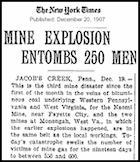 On
December 19, 1907 an explosion in the Darr Mine took the lives of an estimated
239 men and teenage boys. Though
most of those killed were Hungarian immigrant laborers, AHF honors all
those that sacrificed their lives. The Darr Mine Disaster is known as
the worst in Pennsylvania history and 2nd worst in US history. The gas
and dust explosion occurred in the
Deadliest Month in US Mining History. On
December 19, 1907 an explosion in the Darr Mine took the lives of an estimated
239 men and teenage boys. Though
most of those killed were Hungarian immigrant laborers, AHF honors all
those that sacrificed their lives. The Darr Mine Disaster is known as
the worst in Pennsylvania history and 2nd worst in US history. The gas
and dust explosion occurred in the
Deadliest Month in US Mining History.
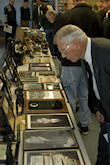 Prior
to the ceremony, guests enjoyed exhibits on mining that featured the unique
collection of Don Indof, son of the legendary "Mr. Miner" Henry
Indof, and a display on mine safety from the Mine
Safety and Health Administration. Prior
to the ceremony, guests enjoyed exhibits on mining that featured the unique
collection of Don Indof, son of the legendary "Mr. Miner" Henry
Indof, and a display on mine safety from the Mine
Safety and Health Administration.
 It
was standing room only as some 300 people attended the church ceremony
that featured presentations by Hungarian-American leaders and local, state,
and federal representatives. Local community representatives included
miners, firefighters, the Masonic Lodge, and those that lost family members
in the disaster. It
was standing room only as some 300 people attended the church ceremony
that featured presentations by Hungarian-American leaders and local, state,
and federal representatives. Local community representatives included
miners, firefighters, the Masonic Lodge, and those that lost family members
in the disaster.
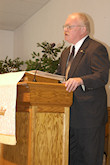 Rev.
Imre Bertalan, Jr., president of the Bethlen
Communities in Ligonier, opened the day and offered welcoming remarks
[download
remarks]. AHF Executive Chairman, Bryan Dawson, accompanied by Raymond
Kimball, led the national anthems of the United States and Hungary, followed
by the Invocation by Rev. Stefan Torok of the Hungarian
Reformed Church. Rev.
Imre Bertalan, Jr., president of the Bethlen
Communities in Ligonier, opened the day and offered welcoming remarks
[download
remarks]. AHF Executive Chairman, Bryan Dawson, accompanied by Raymond
Kimball, led the national anthems of the United States and Hungary, followed
by the Invocation by Rev. Stefan Torok of the Hungarian
Reformed Church.
 Pastor
Chip Norton, a Darr Mine Historian, delivered the Keynote Address and
described the horrors of the massive explosion and the continuing tragedy
as the widows, who often lost their husbands and all male children, were
left homeless Pastor
Chip Norton, a Darr Mine Historian, delivered the Keynote Address and
described the horrors of the massive explosion and the continuing tragedy
as the widows, who often lost their husbands and all male children, were
left homeless  and
penniless. "May we remember not just the event, but that these were
real people with real cities from where they had migrated, real towns
where they lived, real wives who they lo and
penniless. "May we remember not just the event, but that these were
real people with real cities from where they had migrated, real towns
where they lived, real wives who they lo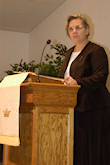 ved,
real children who were the apples of their eyes. May we learn we are never
far from the gates of eternity ourselves," he said. While the "official"
estimate is 239 victims, ev. Norton called attention to other news reports
and estimates that were much higher. The blast was so powerful that many
just weren't identified or known. Children often followed their fathers
into the mines and entire families were wiped out. ved,
real children who were the apples of their eyes. May we learn we are never
far from the gates of eternity ourselves," he said. While the "official"
estimate is 239 victims, ev. Norton called attention to other news reports
and estimates that were much higher. The blast was so powerful that many
just weren't identified or known. Children often followed their fathers
into the mines and entire families were wiped out.
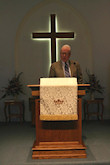 Sponsor
addresses followed. Speakers were Zoltan Bagdy, AHF Co-President; Rev.
Ilona Komjathy, Pastor of the First Hungarian Reformed Church of Pittsburgh;
Endre Csoman, The
William Penn Association; Steven Varga, Chairman of The William Penn
Association and AHF President ex-Officio and Board Member of both AHF
and HAC, who read a letter from the Hungarian American Coalition; Jos Sponsor
addresses followed. Speakers were Zoltan Bagdy, AHF Co-President; Rev.
Ilona Komjathy, Pastor of the First Hungarian Reformed Church of Pittsburgh;
Endre Csoman, The
William Penn Association; Steven Varga, Chairman of The William Penn
Association and AHF President ex-Officio and Board Member of both AHF
and HAC, who read a letter from the Hungarian American Coalition; Jos eph
Fabry, Hungarian Reformed Federation of
America; Rev. Stefan Torok, Hungarian
Reformed Church; and Raymond D. Popp, President, Rostraver
Township
Historical Society. eph
Fabry, Hungarian Reformed Federation of
America; Rev. Stefan Torok, Hungarian
Reformed Church; and Raymond D. Popp, President, Rostraver
Township
Historical Society.
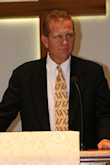 The
Honorable Kevin Stricklin, Administrator, Mine
Safety and Health Administration, U.S. Department of Labor, gave a
stirring speech, commenting on his own Hungarian mining background and
the need for continued vigilance as mining disasters continue. A native
of Wickhaven, PA, Stricklin said the while newer regulations gave more
authority to federal inspectors to shut down mines and more recent penalties
and improved technologies have improved safety, there is much work left
to do. "When I go out to meet with the widow, I can tell you one
miner dying is one too many." The
Honorable Kevin Stricklin, Administrator, Mine
Safety and Health Administration, U.S. Department of Labor, gave a
stirring speech, commenting on his own Hungarian mining background and
the need for continued vigilance as mining disasters continue. A native
of Wickhaven, PA, Stricklin said the while newer regulations gave more
authority to federal inspectors to shut down mines and more recent penalties
and improved technologies have improved safety, there is much work left
to do. "When I go out to meet with the widow, I can tell you one
miner dying is one too many."  He
added that it is unfortunate that so many US laws are "written in
blood." AHF's Bryan Dawson presented him its membership pin and a
copy of its Darr Mine poster. After the day was over, he said, "This
is a very special event for me. I grew up here, I have family here, my
Hungarian ancestors mined here." He joined Pennsylvania State Reprentative
Ted Harhai in thanking the Federation for its work. He
added that it is unfortunate that so many US laws are "written in
blood." AHF's Bryan Dawson presented him its membership pin and a
copy of its Darr Mine poster. After the day was over, he said, "This
is a very special event for me. I grew up here, I have family here, my
Hungarian ancestors mined here." He joined Pennsylvania State Reprentative
Ted Harhai in thanking the Federation for its work.
 Mr.
Stricklin was followed by Edward Yankovich, International Vice President
of the United Mine Workers
of America who focused on the need to protect workers and the continued
sacrifices of so many. Mr.
Stricklin was followed by Edward Yankovich, International Vice President
of the United Mine Workers
of America who focused on the need to protect workers and the continued
sacrifices of so many. 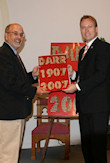 Audible
shock could be heard as he reported that 100,000 miners have died in mining
accidents since the Darr Mine tragedy and 100,000 miners have succumbed
to Black Lung disease. He asked what the miners of old would expect of
us today. "I believe they would want us to continue the fight for
human life and safety. I believe they would want us to embrace them and
help them see through the corporate greed that tries to use us against
them." AHF presented Mr. Yankovich with a copy of its Darr Mine commemorative
poster. Audible
shock could be heard as he reported that 100,000 miners have died in mining
accidents since the Darr Mine tragedy and 100,000 miners have succumbed
to Black Lung disease. He asked what the miners of old would expect of
us today. "I believe they would want us to continue the fight for
human life and safety. I believe they would want us to embrace them and
help them see through the corporate greed that tries to use us against
them." AHF presented Mr. Yankovich with a copy of its Darr Mine commemorative
poster.
 Mary
Lou Pécsi Magiske, corresponding secretary of the Rostraver Township
Historical Society whose grandfather was killed in the Peters Creek Mine
in 1909 and Joe Iacoboni, Rostraver Mary
Lou Pécsi Magiske, corresponding secretary of the Rostraver Township
Historical Society whose grandfather was killed in the Peters Creek Mine
in 1909 and Joe Iacoboni, Rostraver  Township
Commissioner, were the final speakers. Mr Iacoboni presented a proclamation
and expressed his gratitude for all those who came to Rostraver to remember
the victims. Township
Commissioner, were the final speakers. Mr Iacoboni presented a proclamation
and expressed his gratitude for all those who came to Rostraver to remember
the victims.
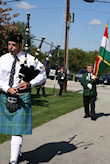 The
Procession to the Cemetery The
Procession to the Cemetery
Following the church ceremony, participants followed bagpiper Scott Hamilton
and the Perryopolis VFW Post 7023 Honor Guard to the adjacent Olive Branch
Cemetery for presentation of the colors 21-gun
salute commanded by George Timko. Bishop Koloman Ludwig, Calvin Synod,
United Church of Christ and Tony Fao, Chaplain of VFW Post 7023 offered
prayers for the dead. 21-gun
salute commanded by George Timko. Bishop Koloman Ludwig, Calvin Synod,
United Church of Christ and Tony Fao, Chaplain of VFW Post 7023 offered
prayers for the dead.
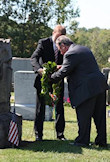 The
Olive Branch Cemetery is the final resting place for 71 Darr miners. Hungarian
American leaders laid a wreath at the AHF Memorial which sits above a
common grave where the remains of some 49 miners are The
Olive Branch Cemetery is the final resting place for 71 Darr miners. Hungarian
American leaders laid a wreath at the AHF Memorial which sits above a
common grave where the remains of some 49 miners are  buried.There
is a single grave of a Darr miner near the AHF Memorial marked Helmuth
Schneider. The VFW Post 7023 Honor Guard presented arms and a 10-gun salute
commanded by George Timko. Participants observed silent reflection as
students from the Frazier School District played Taps. buried.There
is a single grave of a Darr miner near the AHF Memorial marked Helmuth
Schneider. The VFW Post 7023 Honor Guard presented arms and a 10-gun salute
commanded by George Timko. Participants observed silent reflection as
students from the Frazier School District played Taps.
The AHF memorial, placed in 1909 on the second anniversary of the tragedy,
was partially funded by Austro-Hungarian Emperor Franz Joseph. The Memorial
reads:
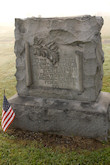 "To
the Memory "To
the Memory
of the Martyrs
The Darr Mine Disaster
Dec. 19,1907
Erected by the
Hungarian-American
Federation
1909"
The commemoration ended as the bagpipes slowly faded away playing "Amazing
Grac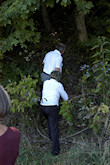 e." e."
Visit to the Mine Site
With the official ceremonies over, some participants attended a tour
of the Darr Mine site. They scaled the overgrown hill to find the brick-covered
entrance to the mine. The explosion from this entrance was so powerful
it was felt miles away.
 The
bodies were brought down the hill to the village of Van Meter. There,
local historians and residents shared their knowledge of the dramatic
events following the Darr disaster with comm The
bodies were brought down the hill to the village of Van Meter. There,
local historians and residents shared their knowledge of the dramatic
events following the Darr disaster with comm emoration
participants. Many of the original buildings still exist and a memorial
was placed near the site of the makeshift morgue. Joseph Sbaffoni, Que
Creek Mine Rescue Miner, talked about mine safety and his experiences. emoration
participants. Many of the original buildings still exist and a memorial
was placed near the site of the makeshift morgue. Joseph Sbaffoni, Que
Creek Mine Rescue Miner, talked about mine safety and his experiences.
Alex Bodnar sang the Hungarian Miner's Anthem (Bányász
himnusz). Alex is owner of a Hungarian restaurant in suburban Pittsburgh.called
Jozsa's Corner.
Szerencse Fel! / Fortune's Up!
Szerencse fel, szerencse le;
Ilyen a bányász élete.
Váratlan vész rohanja meg,
Mint bérctetot a fergeteg.
Nem kincs után sóvárgok én,
Bányász kislányt óhajtok én.
Bányász kislányt óhajt szívem,
Ki szívében bányász legyen.
És hogyha majd a föld ölében végóránkat
éljük,
Isten kezében életünk. O megsegít reméljük!
Te kisleány ne bánkódjál,
Bányászként halni szép halál!
Egekbe szállani fel, fel Szerencse fel,
Szerencse fel, szerencse fel! |
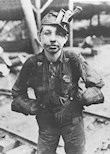
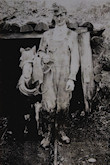

|
Reception
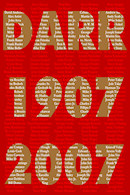 A
reception was held in Belle Vernon. AHF's Bryan Dawson presented Raymond
Popp with the full-size Darr Mine poster and thanked him and Mary Lou
Pécsi Magiske of the Rostraver Township Historical Society for
all their support and hard work. A
reception was held in Belle Vernon. AHF's Bryan Dawson presented Raymond
Popp with the full-size Darr Mine poster and thanked him and Mary Lou
Pécsi Magiske of the Rostraver Township Historical Society for
all their support and hard work.
He recalled the months of planning that went in to the event, thanked
all the sponsoring organizations and remarked that when the community
shows such unity, nothing was impossible.
About the Darr
Mine Disaster
 December
1907 began with an explosion that killed all 34 miners inside the Naomi
Mine in Fayette County on Dec. 1. Five days la December
1907 began with an explosion that killed all 34 miners inside the Naomi
Mine in Fayette County on Dec. 1. Five days la ter,
the single greatest mine disaster in American history occurred when massive
explosions and roof collapses killed 362 men in Monongah, West Va. Ten
days later, on Dec.16, an explosion in the Yolanda, Ala. killed 57 miners,
many by asphyxiation. By the time this deadly month ended, more than 3,200
American miners had died in accidents. In Pennsylvania, 1,400 miners died
that year, 708 in the Anthracite mines, and 806 in the Bituminous fields. ter,
the single greatest mine disaster in American history occurred when massive
explosions and roof collapses killed 362 men in Monongah, West Va. Ten
days later, on Dec.16, an explosion in the Yolanda, Ala. killed 57 miners,
many by asphyxiation. By the time this deadly month ended, more than 3,200
American miners had died in accidents. In Pennsylvania, 1,400 miners died
that year, 708 in the Anthracite mines, and 806 in the Bituminous fields.
Why so many Hungarians?
 The
total dead at Darr could have been much higher, eclipsing even the
Monangah disaster, if not for the fact that many of the miners were recent
immigrants of the Greek Catholic and Greek Orthodox faith which celebrates
the Feast of The
total dead at Darr could have been much higher, eclipsing even the
Monangah disaster, if not for the fact that many of the miners were recent
immigrants of the Greek Catholic and Greek Orthodox faith which celebrates
the Feast of 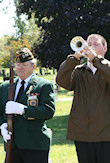 St.
Nicholas on December 19 according to the Julian calendar. As a result,
nearly 200 miners chose not to go to work the day the explosion happened.
Those that chose to work that day were mostly Hungarian, Italian, German,
and Austrian immigrants. "The Miracle of St. Nicholas," celebrated
by some of the Orthodox faith as hundreds were saved that day, did not
extend to these poor Darr miners. Of the estimated 239 dead, over 140
were Hungarian. St.
Nicholas on December 19 according to the Julian calendar. As a result,
nearly 200 miners chose not to go to work the day the explosion happened.
Those that chose to work that day were mostly Hungarian, Italian, German,
and Austrian immigrants. "The Miracle of St. Nicholas," celebrated
by some of the Orthodox faith as hundreds were saved that day, did not
extend to these poor Darr miners. Of the estimated 239 dead, over 140
were Hungarian.
Honoring the Dead
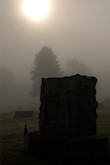 The
American Hungarian Federation (then known as the Hungarian American Federation)
placed the memorial over a common grave at Olive Branch in 1909. An inquiry
into the disaster afterwards concluded, as was usually the case in that
period of Pennsylvania coal mining, that the Pittsburgh Coal Company was
not at fault. The
American Hungarian Federation (then known as the Hungarian American Federation)
placed the memorial over a common grave at Olive Branch in 1909. An inquiry
into the disaster afterwards concluded, as was usually the case in that
period of Pennsylvania coal mining, that the Pittsburgh Coal Company was
not at fault.
 Pete
Starry, a mining historian, provided an interesting article to the The
Coal Miner's Memorial. It was The United Mine Workers Journal from Dec.
1, 1957, entitled, "Main Thing was Management Neglect" Pete
Starry, a mining historian, provided an interesting article to the The
Coal Miner's Memorial. It was The United Mine Workers Journal from Dec.
1, 1957, entitled, "Main Thing was Management Neglect"
 "All
of the mining disasters of December, 1907 had several things in common.
The main thing was management neglect and in some cases brutal criminal
negligence. Black powder was used for blasting in all of these stricken
mines. Coal dust was allowed to accumulate in spite of warnings from
England that it was highly explosive. All of the mines were gassy and
seem to have been poorly ventilated. It is quite possible that the Jacobs
Creek disaster wou "All
of the mining disasters of December, 1907 had several things in common.
The main thing was management neglect and in some cases brutal criminal
negligence. Black powder was used for blasting in all of these stricken
mines. Coal dust was allowed to accumulate in spite of warnings from
England that it was highly explosive. All of the mines were gassy and
seem to have been poorly ventilated. It is quite possible that the Jacobs
Creek disaster wou ld
not have taken place if the men had been allowed by Providence one more
day to dig out 40 feet of coal to reach a new shaft the company had
sunk in an effort to improve ventilation in the mine. ld
not have taken place if the men had been allowed by Providence one more
day to dig out 40 feet of coal to reach a new shaft the company had
sunk in an effort to improve ventilation in the mine.
 One
of the victims of the explosion
was a mine foreman, H.S. Campbell. His widow reported that his main
preoccupation and worry in the months preceeding the blast was with
the gassy condition and poor ventilation in the Darr Mine. He pestered
the company about it and it was at his urging that the new ventilating One
of the victims of the explosion
was a mine foreman, H.S. Campbell. His widow reported that his main
preoccupation and worry in the months preceeding the blast was with
the gassy condition and poor ventilation in the Darr Mine. He pestered
the company about it and it was at his urging that the new ventilating shaft had been sunk. Campbell's worry, which made him tell his wife
he could not even think about Christmas, goaded the company into action,
but it was 24 hours too late for 239 men."
shaft had been sunk. Campbell's worry, which made him tell his wife
he could not even think about Christmas, goaded the company into action,
but it was 24 hours too late for 239 men."
The Darr Mine Relief Committee
Report
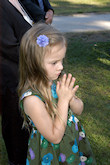 Below
are edited excerpts of a report on the relief efforts undertaken by a
newly formed "Darr Mine Relief Committee." While the efforts
were certainly appreciated, the opinions expressed regarding the victims
and their families exemplifies the attitudes of the time toward these
"ignorant" second-class people. The report was entitled, Below
are edited excerpts of a report on the relief efforts undertaken by a
newly formed "Darr Mine Relief Committee." While the efforts
were certainly appreciated, the opinions expressed regarding the victims
and their families exemplifies the attitudes of the time toward these
"ignorant" second-class people. The report was entitled,  "Darr
Mine Relief Fund Report to the Executive Committee covering the Collection
and Distribution of the Public Fund for the Dependents of the Men Killed
by the Explosion in the Darr Mine of the Pittsburgh Coal Company December
19th, 1907." "Darr
Mine Relief Fund Report to the Executive Committee covering the Collection
and Distribution of the Public Fund for the Dependents of the Men Killed
by the Explosion in the Darr Mine of the Pittsburgh Coal Company December
19th, 1907."
 [On
December 26th a public meeting to consider measures for relief, commensurate
with the magnitude of the disaster, was held in the office of Pittsburgh
Mayor Guthire. It was attended by the Mayors of Pittsburgh, McKeesport
and Connellsville, the President and Vice-President of the Mine Workers'
Union, the Austro-Hungarian and the Italian Consuls and many others. The
Darr Mine Relief Committee was then formed for the purpose of coordinating
the various efforts for relief. [On
December 26th a public meeting to consider measures for relief, commensurate
with the magnitude of the disaster, was held in the office of Pittsburgh
Mayor Guthire. It was attended by the Mayors of Pittsburgh, McKeesport
and Connellsville, the President and Vice-President of the Mine Workers'
Union, the Austro-Hungarian and the Italian Consuls and many others. The
Darr Mine Relief Committee was then formed for the purpose of coordinating
the various efforts for relief.
 The
committee began campaigning on behalf of a relief fund on January 2nd,
1908. Sixty-two thousand copies of an appeal were distributed among
the people of Pittsburgh and other cities and special personal letters
were addressed to persons of wealth, to those engaged in the coal business
and to consumers of the product of the Pittsburgh coal field in the
United States and Canada... The
committee began campaigning on behalf of a relief fund on January 2nd,
1908. Sixty-two thousand copies of an appeal were distributed among
the people of Pittsburgh and other cities and special personal letters
were addressed to persons of wealth, to those engaged in the coal business
and to consumers of the product of the Pittsburgh coal field in the
United States and Canada...
 The
task of dealing with this class of people, many of them shiftless and
ignorant, the great majority of them unable to speak the English language,
and unfamiliar with American ways and manner of living, was performed
with firmness and good judgment, tempered with sympathy, by Mr. Minker
and his assistants... The
task of dealing with this class of people, many of them shiftless and
ignorant, the great majority of them unable to speak the English language,
and unfamiliar with American ways and manner of living, was performed
with firmness and good judgment, tempered with sympathy, by Mr. Minker
and his assistants...
 However,
as is always to be expected from this class, complaints of neglect and
dissatisfaction, the most bitter coming from those who had received
most, found their way into the newspapers and were even addressed to
the Governor of the State... However,
as is always to be expected from this class, complaints of neglect and
dissatisfaction, the most bitter coming from those who had received
most, found their way into the newspapers and were even addressed to
the Governor of the State...
 Of
the total subscriptions $25,000.00 was contributed by the Carnegie Hero
Fund, and $20,000.00 by the Pittsburgh Coal Company. The balance of
$52,062.53 was from all other sources, in all about 3,000 contributions
as acknowledged day by day, in the Pittsburgh newspapers.] [download
the full report] Of
the total subscriptions $25,000.00 was contributed by the Carnegie Hero
Fund, and $20,000.00 by the Pittsburgh Coal Company. The balance of
$52,062.53 was from all other sources, in all about 3,000 contributions
as acknowledged day by day, in the Pittsburgh newspapers.] [download
the full report]
Miners families received a $150.00 death benefit (some received additional
assistance totalling $249.00) and were asked to leave the company-owned
homes. The Hungarian community stepped in to help the orphans and widows.
Today, as a direct result of this disaster, there are few Hungarian families
left in the area. Most, if not all, were forced to relocate.
But the miners did not die in
vain.
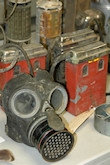 The
PA EPA wrote: "The Darr and Monongha disasters marked the first use
of self-contained breathing apparatus in a deep-mine rescue in the United
States. Other major advances in mine safety followed soon after. Within
six months the U.S. Geological Survey created the Mine Accidents Division
and opened a station devoted to research of mine rescue techniques The
PA EPA wrote: "The Darr and Monongha disasters marked the first use
of self-contained breathing apparatus in a deep-mine rescue in the United
States. Other major advances in mine safety followed soon after. Within
six months the U.S. Geological Survey created the Mine Accidents Division
and opened a station devoted to research of mine rescue techniques in Pittsburgh. In two years, branch stations were established in Illinois,
Tennessee and Washington. And on July 1, 1910 an Act of Congress established
the U.S. Bureau of Mines.
in Pittsburgh. In two years, branch stations were established in Illinois,
Tennessee and Washington. And on July 1, 1910 an Act of Congress established
the U.S. Bureau of Mines.
 The
following year, the number of mining fatalities began to drop, and never
again approached the horrific total of 1907. In 1954, the number of mining
fatalities dropped below 100 for the first time since mining began in
Pennsylvania. Although deep mining remains a dangerous occupation, advances
in knowledge, equipment and regulations have combined to make Pennsylvania's
Deep Mine Safety program a national model." The
following year, the number of mining fatalities began to drop, and never
again approached the horrific total of 1907. In 1954, the number of mining
fatalities dropped below 100 for the first time since mining began in
Pennsylvania. Although deep mining remains a dangerous occupation, advances
in knowledge, equipment and regulations have combined to make Pennsylvania's
Deep Mine Safety program a national model."
Pennsylvania House
Honors the Victims
AHF thanks all those involved, including state representatives
Mark Gergely, Tom Harhai and all co-sponsors of Pennsylvania
House Resolution 401, honoring the Victims of the Darr Mine Disaster.
- Bryan Dawson (photos courtesy Bryan Dawson and Les
Banos)
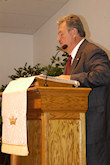
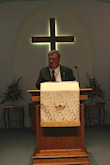
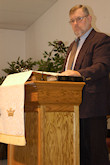
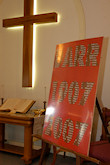











































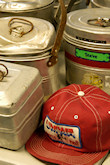
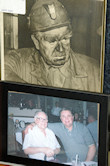 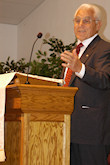
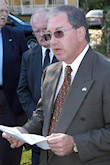
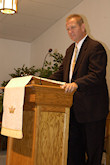

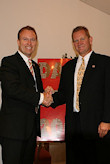



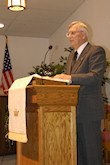
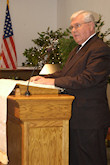
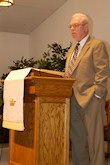
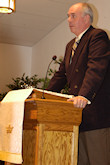



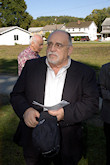
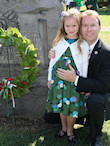
[back to all AHF news] |

"To the Memory
of the Martyrs
The Darr Mine Disaster
Dec. 19,1907
Erected by the
Hungarian-American
Federation
1909" Sponsoring organizations issued a joint statement, saying,
"We affirm that the sacrifices were not in vain, and we pledge ourselves
to continue working together for the good of humankind.
Links:
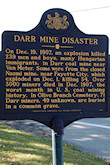 Pennsylvania
Historical & Museum Commission Historic Site Marker honoring
the coal miners killed in the Darr Mine Explosion, Dec. 19, 1907. The
plaque is located at the Olive Branch Cemetery, on PA Route 981 between
PA Route 51 and Smithton, PA. The marker was not erected until September
1994. Pennsylvania
Historical & Museum Commission Historic Site Marker honoring
the coal miners killed in the Darr Mine Explosion, Dec. 19, 1907. The
plaque is located at the Olive Branch Cemetery, on PA Route 981 between
PA Route 51 and Smithton, PA. The marker was not erected until September
1994.
The plaque reads as follows:
"On December 19, 1907, an explosion killed 239 men
and boys, many Hungarian immigrants, in Darr coal mine near Van Meter.
Some were from the closed Naomi mine near Fayette City, which exploded
on Dec. 1, killing 34. Over 3000 miners died in Dec. 1907, the worst month
in U. S. coal mining history. In Olive Branch Cemetery, 71 Darr miners,
49 unknown, are buried in a common grave."
The American Hungarian Federation
(AHF), a non-profit 501(c)(3) organization, was founded in 1906 in Cleveland,
Ohio. The largest Hungarian-American umbrella organization in the United
States, AHF is also among the oldest ethnic organizations in the country.
AHF was established as an association of Hungarian societies, institutions
and churches to "defend the interest of Americans of Hungarian origin
in the United States." Read more [about us]
or
Contribute or join
online!

 Sign
up for the AHF mailing list. Sign
up for the AHF mailing list.
Your information is not shared!
|



